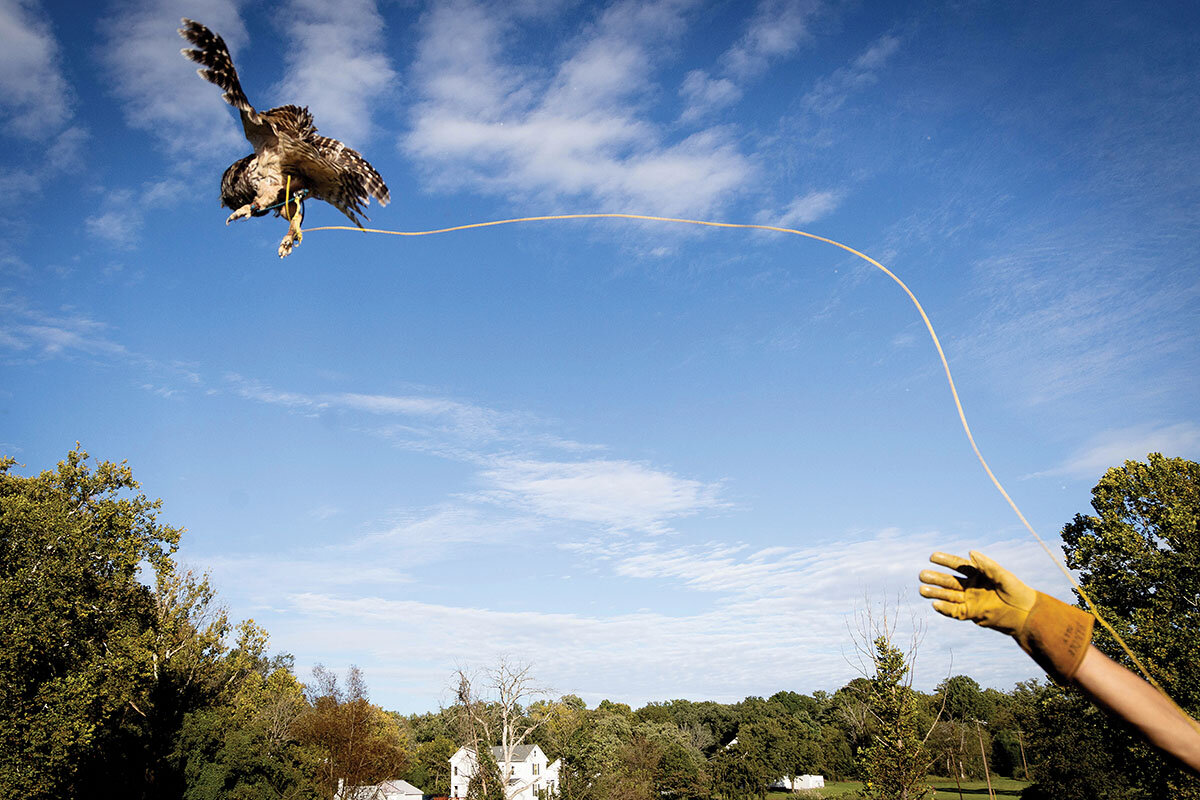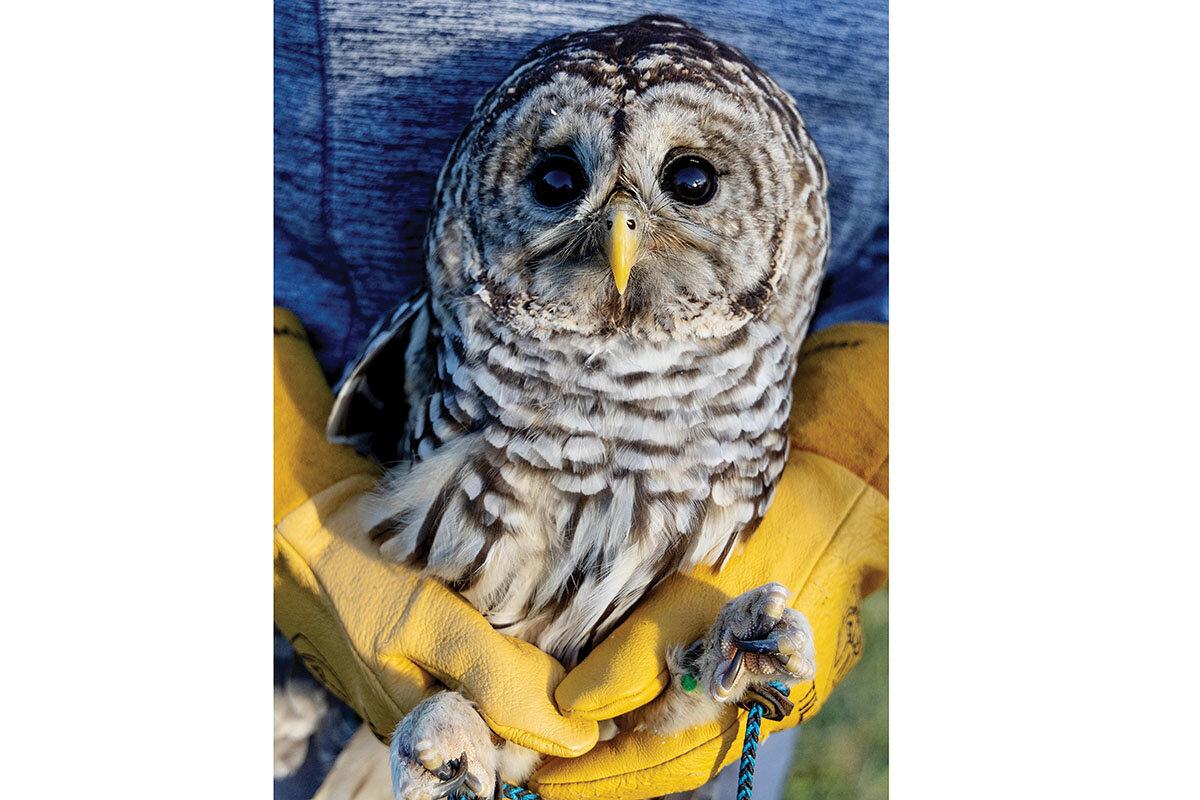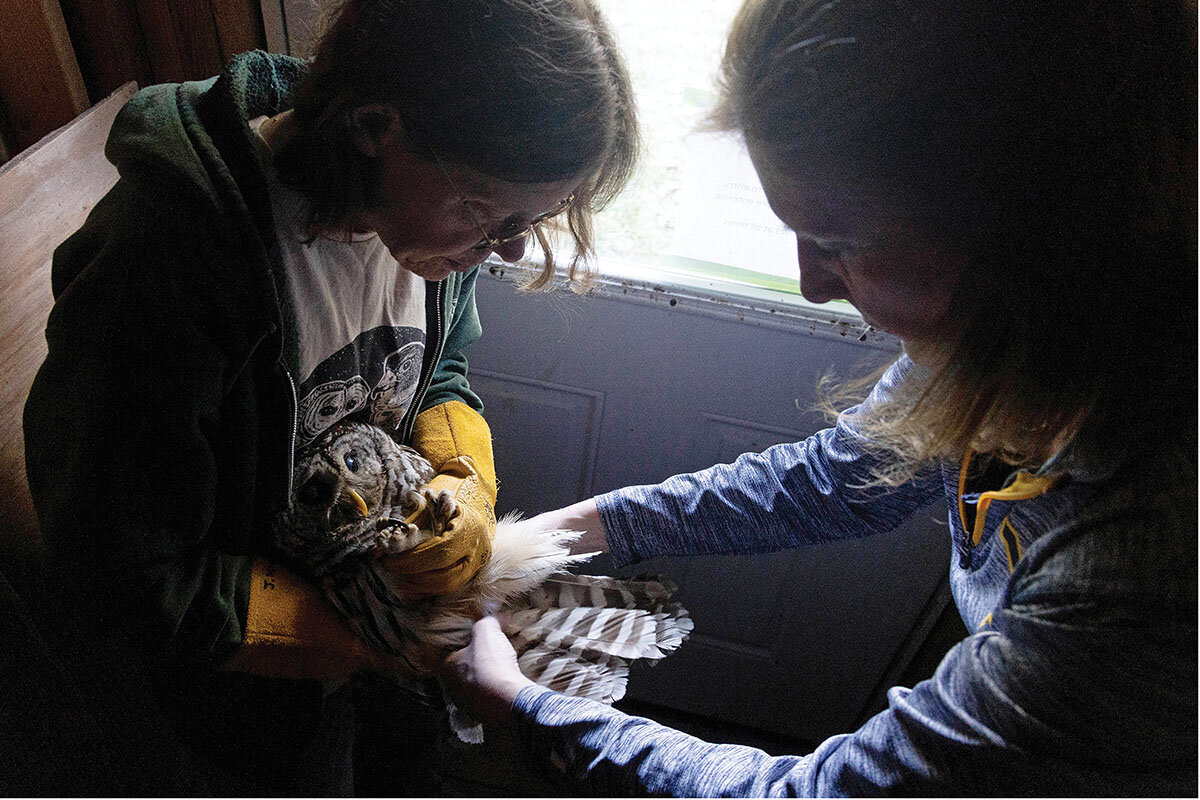When raptors and urbanization collide, these volunteers are there to help
Loading...
| Boyds, Md.
When light floods into its cage, the young kestrel hops from side to side, spunky despite its invalid status, and stares expectantly with sharp, bright eyes. It wants food and has learned – in two months – that breakfast follows closely after the black cloth over its cage is lifted.
“This one has imprinted,” says Suzanne Shoemaker, rueful because it can’t be released after bonding with a human.
Ms. Shoemaker’s work revolves around a contradiction of sorts: She loves birds of prey and has dedicated her career to them, but the fewer birds she cares for – and the shorter they stay with her – the better. She founded Owl Moon Raptor Center 20 years ago and, with a growing number of volunteers, rehabilitates birds of prey – 408 stewarded just this year.
Why We Wrote This
A story focused onOwl Moon Raptor Center volunteers take responsibility for birds of prey needing rehabilitation after they collide with the windows and power lines of urbanization.
The kestrel lives in a cage in a room jokingly referred to as “the ICU,” the first temporary home for raptors that come to the center with injuries that make flying unsafe. This kestrel will stay in a cage big enough for it to spread its wings and walk about, but too small for it to fly. Once its shoulder fracture heals enough to be more mobile, it will be moved into a mew – a space resembling a stall with walls extending up to a vaulted ceiling. Soon after, it will be exercised on a line, and when able to fly freely, it will be released where it was found.
To discourage bonding, Ms. Shoemaker wears a camouflage ghillie suit when she gives hands-on care. While mature raptors rarely imprint on humans, it’s harder to avoid with adolescents like the kestrel.
The land around Owl Moon Raptor Center offers a stark illustration of human effects on birds of prey. The center is in an agricultural reserve, and the roads leading there wind through fields dotted with ranch-style homes and farmhouses. But abruptly, the roads widen, stop signs turn to traffic lights, and open spaces become sprawling developments. Ms. Shoemaker has warily eyed the encroaching development for two decades, knowing that raptor injuries can almost always be traced back to humans.
The battle between localities and conservationists with other interest groups to limit development is constant, says Jensen Montambault, director of the Nature Conservancy’s Science for Nature and People Partnership. The answer, she says, is often in national conversations that include hyperlocal organizations like Owl Moon because “human behavior change is the key to conservation.”
The most significant piece of legislation protecting birds of prey, the Migratory Bird Treaty Act of 1918, was created when hunting was the biggest threat to birds of prey, Dr. Montambault says, so it doesn’t address development. Groups like Owl Moon see firsthand the threats human activities can pose. “I just want to do the best job I can for the birds,” says Ms. Shoemaker. “That’s always been my goal: to try to minimize the human impact on them.”
“They’re characters”
“Animals were always my passion,” says Ms. Shoemaker, sitting at her kitchen table with owl mugs lining a shelf, bird feeders hanging outside the window, and bees buzzing around an apiary on the driveway.
A calm, slight woman, she’s integrated family life with her passion. Along with teaching her own environmental education classes, she volunteered in preservation efforts alongside her children. While volunteering for a wildlife rehabilitation center, she realized it did good work for a broad range of wildlife, but she wanted to have a narrower focus: “You could do a better job if you specialized.”
She’d always been intrigued by raptors, so they were a natural choice for her own center. “They’re wild. They’re characters.”
And each species has its own characteristics, she says. Barred owls, for example, “are spunky and fight hard” but have a mischievous streak and like to shred newspapers.
She founded Owl Moon Raptor Center with two mews in her backyard and several cages in her basement. Now, the center has nine mews, a room full of caging, and a barn with caging for larger raptors, and it serves Maryland and parts of Virginia and Pennsylvania. These days, the average number of raptors here is around 35 or 40. When Ms. Shoemaker started the center, she worked alone rehabilitating one or two birds at a time. Now, she works alongside one paid employee and 35 volunteers – plus a network
of more than 100 people who transport raptors. And Owl Moon is now a registered nonprofit, funded by grants from wildlife rescue groups and an annual fundraiser.
Ms. Shoemaker has licenses in falconry and rehab, as well as a master’s degree in falconry. She has picked up veterinary skills, although raptors are sent to practicing vets for major surgeries.
The ideal, always, is to rehabilitate raptors and set them free, says Ms. Shoemaker. If they imprint on caretakers or their injuries are too extensive to heal fully, the next best option is to train the birds for an educational center. If that isn’t possible or the injuries are too severe, they must be euthanized.
Windows a common threat
Common threats to raptors are windows, fishing line, power lines, lead ammunition, and cars, says Ms. Shoemaker: “I want to mitigate some of the problems that we’re creating out there, because we’re just
creating so many hazards.”
But, she adds, sometimes it feels like an uphill battle, and “it’s harder and harder to believe that I can make a difference.”
Some threats that leave traces that raptors may ingest through prey should be highly regulated, she says, like rodenticide. Others, like lead ammunition, should be banned.
She notes that power companies are starting to respond to concerns and in some places are building platforms where ospreys can nest safely above power lines.
Although she has periodic speaking engagements as a conservationist, Ms. Shoemaker spends her day to day with the raptors. Recently, she implanted new feathers into the wings of an osprey that had broken some. It took three sittings and five hours total to trim down the broken feathers and implant new feathers into the old shafts.
“But it’s worth it,” she says, “because then the bird looks like new and it can fly a whole lot better.”
Ms. Shoemaker says the real joy of working with raptors is releasing them: “It’s what we do this for. These are wild birds and they want to be flying free.”









